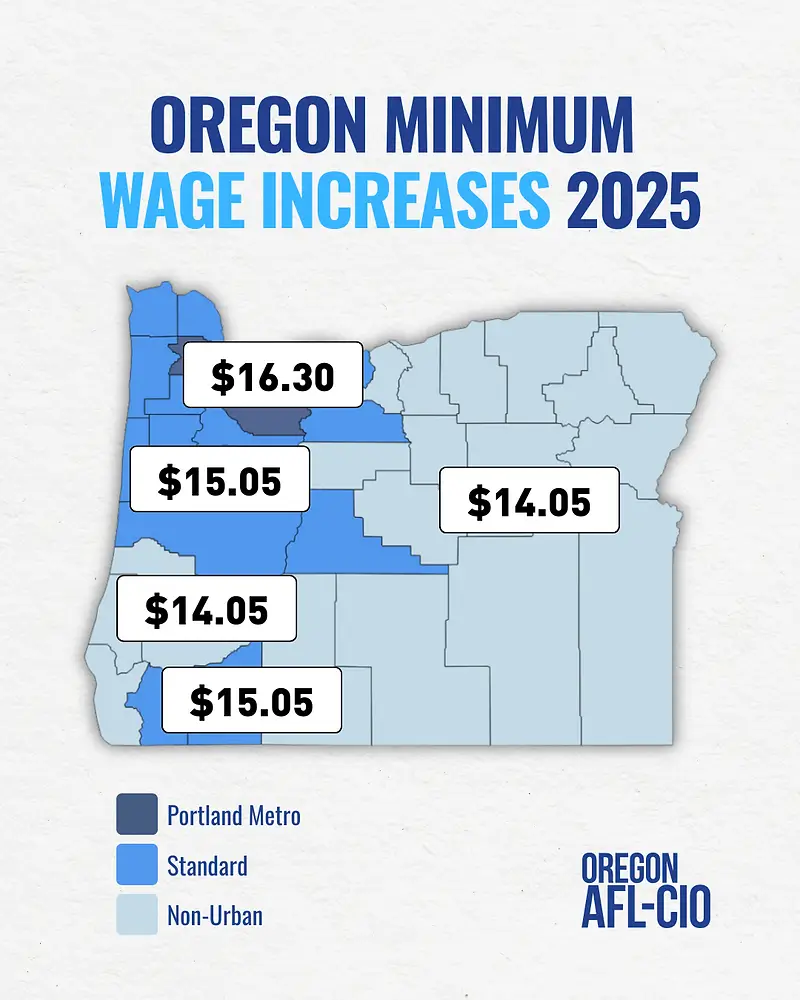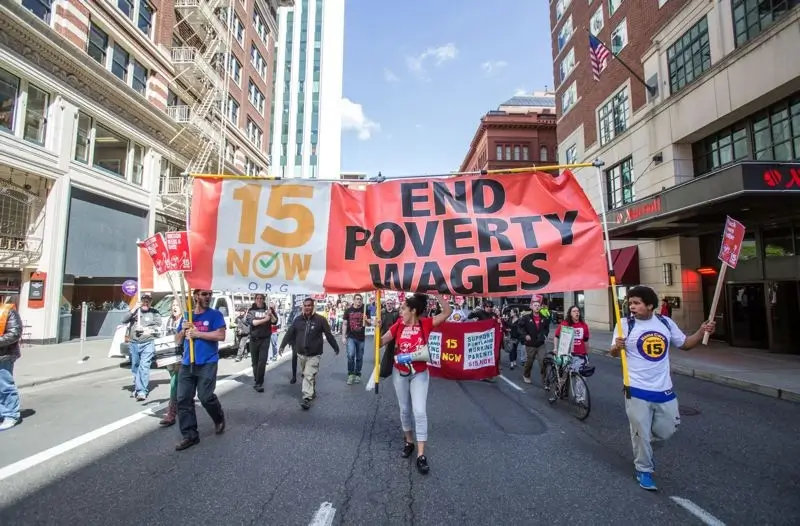The Oregon minimum wage 2025 rates are now officially in effect, with workers in the Portland metro area earning at least $16.30 per hour, standard counties set at $15.05, and non-urban counties at $14.05.

The updated regional tiers, which took effect July 1, 2025, reflect inflation and geographic cost-of-living differences, according to the Oregon Bureau of Labor and Industries (BOLI).
Oregon Minimum Wage 2025
| Key Fact | Detail |
|---|---|
| Portland metro minimum wage | $16.30/hour (inside the Portland urban growth boundary) |
| Standard counties minimum wage | $15.05/hour |
| Non-urban counties minimum wage | $14.05/hour |
How the Oregon Minimum Wage 2025 System Works
Oregon is one of a small number of U.S. states using a regional minimum wage structure instead of a single statewide rate. The law divides the state into three distinct pay zones: Portland metro, standard counties and non-urban counties.
Under this system, employers must pay workers at least the minimum wage tied to the location where the work is actually performed, not the company’s mailing address. If an employee works in more than one region during a pay period, employers may need to pay different rates for different hours or apply the highest rate to all hours to stay clearly compliant.
Guidance from BOLI encourages employers to document where work is performed and to consult the official wage schedule if they are unsure.

The Three Regional Rates Explained
Portland Metro Minimum Wage – $16.30 per Hour
For 2025, the highest rate applies inside the Portland urban growth boundary, covering parts of Multnomah, Washington and Clackamas counties.
According to BOLI, employers should use an official map or address-lookup tool to confirm whether a particular worksite is inside this boundary. This Portland metro minimum wage increased from $15.95 to $16.30 on July 1, 2025, reflecting year-over-year inflation measured by the U.S. City Average Consumer Price Index for All Urban Consumers (CPI-U).
Standard Counties – $15.05 per Hour
The standard rate of $15.05 per hour applies to most of Oregon’s population centers outside the Portland urban growth boundary and not designated as non-urban. This includes counties such as Benton, Clatsop, Columbia, Deschutes, Hood River, Jackson, Josephine, Lane, Lincoln, Linn, Marion, Polk, Tillamook, Wasco and Yamhill, along with parts of the three Portland-area counties that lie outside the boundary.
This tier sits in the middle of the Oregon minimum wage by region structure and covers many of the state’s university towns, coastal communities and mid-sized cities.
Non-Urban Counties – $14.05 per Hour
The non-urban rate of $14.05 per hour applies in designated rural and sparsely populated counties including Baker, Coos, Crook, Curry, Douglas, Gilliam, Grant, Harney, Jefferson, Klamath, Lake, Malheur, Morrow, Sherman, Umatilla, Union, Wallowa and Wheeler.
Legislators and economists have argued that these areas generally have lower housing costs and different economic structures, which is why the non-urban counties minimum wage remains below the Portland metro and standard tiers.
How the Oregon Minimum Wage 2025 Were Calculated
The 2025 increase is part of a longer-term policy that began with Senate Bill 1532, passed in 2016, which created Oregon’s tiered minimum wage structure and set out a schedule of increases through mid-2023. After that date, the law ties further changes to inflation.
Beginning July 1, 2023, Oregon’s minimum wage has been automatically adjusted each July based on changes in the CPI-U. By April 30 each year, BOLI calculates the necessary adjustment for the upcoming July increase and rounds the figure to the nearest five cents.
For July 1, 2025, that process produced the new rates of $16.30 (Portland metro), $15.05 (standard) and $14.05 (non-urban), replacing the 2024 levels of $15.95, $14.70 and $13.70 respectively.
Labor attorneys note that this automatic mechanism removes the need for annual legislative debates, while still giving workers some protection against rising prices.
What the Oregon Minimum Wage 2025 Means for Workers
Annual Income at the New Rates
For a full-time worker at 40 hours per week, 52 weeks per year, gross annual pay at the new rates is:
- Portland metro: 40 × 52 × $16.30 ≈ $33,904
- Standard counties: ≈ $31,304
- Non-urban counties: ≈ $29,224
These figures do not include overtime, benefits or taxes, but they provide a baseline comparison for Oregon minimum wage 2025 earnings.
Who Is Most Affected?
An analysis by Oregon’s labor market information office found that roughly 4 percent of jobs paid at or below the minimum wage in 2024, with an additional share paying between the old and new minimums. In total, more than 130,000 jobs are potentially affected by the 2025 increase.
Minimum-wage jobs are concentrated in retail, food service, hospitality, agriculture and certain healthcare and support roles. Younger workers, women and workers of color are disproportionately represented in these sectors, meaning minimum wage policy can have important equity implications.
No Tip Credit in Oregon
Unlike many states, Oregon does not allow a lower tipped minimum wage. Tipped employees must receive the full applicable regional minimum wage before tips, an important protection in service industries.
Implications for Employers Across Oregon
Determining the Correct Regional Rate
Employers must carefully identify where employees perform work. Guidance from law firms and payroll providers stresses that the rate is tied to the worksite, not the employer’s headquarters. For example, a company based in a standard-rate county that sends staff into Portland for regular assignments must pay those hours at the Portland metro minimum wage.
Employers whose employees move between counties may either track hours by location and apply multiple rates, or, for administrative simplicity, choose to pay the highest applicable rate for all hours.
Pay Periods Crossing July 1, 2025
BOLI notes that when a shift or pay period spans June 30 and July 1, employers must apply the old rate to hours worked before midnight and the new rate to hours after the change.
Payroll departments and small businesses are urged to review timekeeping systems to ensure the changeover is accurately captured, particularly for overnight shifts.
Record-Keeping, Posters and Compliance
Employers are required to:
- Display updated minimum wage posters at each worksite
- Maintain records of hours worked and wages paid
- Ensure that deductions do not bring pay below the applicable regional minimum
Required workplace posters, including translations, can be downloaded from the BOLI website.

How Oregon Compares Nationally
With its 2025 rates, Oregon remains among the states with the highest minimum wages in the country, especially in the Portland metro area. A number of national employer advisories now list Oregon’s $16.30 top rate alongside high-wage jurisdictions like California and the District of Columbia.
However, regionalization means workers in rural Oregon still earn significantly less per hour than those in Portland, a gap that continues to fuel debate about fairness, competitiveness and the risk of job losses in lower-wage areas.
Related Links
New York Sets New Speed Limits for Bicycles and E-Scooters — Here Are the Updated Penalties
Two Social Security Payments Arriving This Week — One Group Receives an Extra Deposit
The Oregon minimum wage 2025 structure, with distinct rates for Portland metro, standard and non-urban regions, reflects the state’s effort to balance rising living costs with concerns about employment and business competitiveness.
As the new rates bed in through mid-2026, both workers and employers are being encouraged to verify their applicable region, review payroll practices and prepare for future inflation-linked adjustments.
FAQs About Oregon Minimum Wage 2025
Q1: Which rate applies if I work remotely from a non-urban county for a Portland-based employer?
The law focuses on where the work is performed, not where the employer is headquartered. If you perform your work in a non-urban county, the non-urban rate of $14.05 applies.
Q2: What if I work in more than one wage region in the same week?
Employers can track hours in each region and pay accordingly or choose to pay the highest applicable rate for all hours.
Q3: Will the Oregon minimum wage 2025 rates change again before June 30, 2026?
Barring new legislation, no. The current rates are scheduled to remain in place from July 1, 2025 through June 30, 2026.
Q4: Are there different minimum wages for youth or trainees?
Oregon does not have a separate, lower statutory minimum wage for youth or trainees. In general, most covered workers are entitled to the same regional minimum wage.
Q5: Where can I confirm whether my county is classified as non-urban?
BOLI publishes a minimum wage schedule and region map listing all non-urban counties.


 Social Security Checks Set for Christmas Eve and New Year’s Eve — Here’s Why the Payment Dates Shift
Social Security Checks Set for Christmas Eve and New Year’s Eve — Here’s Why the Payment Dates Shift First U.S. Guaranteed Income Program: Check Eligibility Criteria and How to Apply
First U.S. Guaranteed Income Program: Check Eligibility Criteria and How to Apply Who Gets the First Social Security Increase in 2026? Check Details of Early Payments
Who Gets the First Social Security Increase in 2026? Check Details of Early Payments January 2026 Social Security Schedule Released — Check Your Payment Date
January 2026 Social Security Schedule Released — Check Your Payment Date